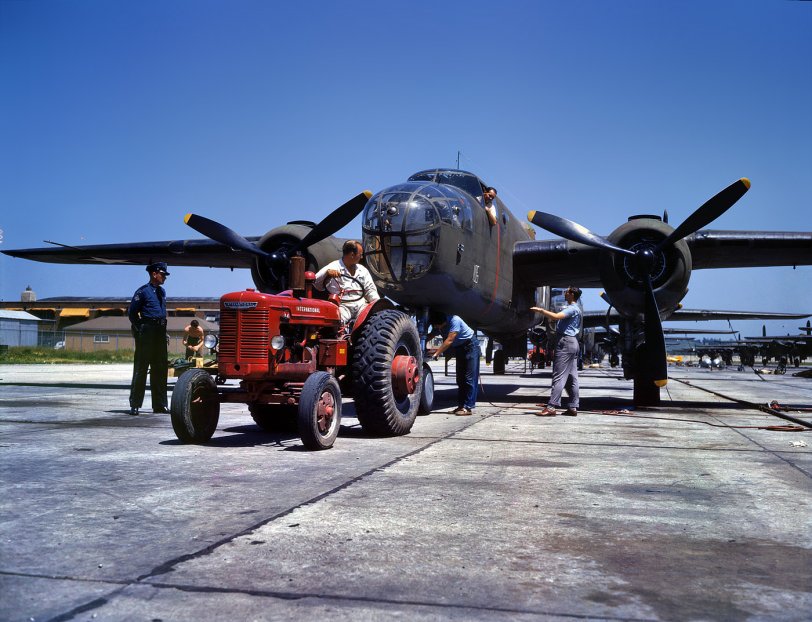


Framed or unframed, desk size to sofa size, printed by us in Arizona and Alabama since 2007. Explore now.
Shorpy is funded by you. Patreon contributors get an ad-free experience.
Learn more.

- Details, Details
- What's that building to the left of the tower?
- Coal Barges
- Bromo-Seltzer
- Inner harbor
- The Basin
- What a headache!
- Giant stepladder?
- Baldwin 62303
- Baldwin VO-1000
- Cold
- No expense spared
- Tough Guys
- Lost in Toyland
- And without gloves
- If I were a blindfolded time traveler
- Smoke Consumer Also Cooks
- Oh that stove!
- Possibly still there?
- What?!?
- $100 Reward
- Freeze Frame
- Texas Flyer wanted
- Just a Year Too Soon
- WWII -- Replacing men with women at the railroad crossing.
- Yes, Icing
- You kids drive me nuts!
- NOT An Easy Job
- I wonder
- Just add window boxes
Print Emporium
Tractor Pull: 1942

October 1942. Kansas City, Kansas. "B-25 bomber plane at North American Aviation being hauled along an outdoor assembly line." View full size. 4x5 Kodachrome transparency by Alfred Palmer for the Office of War Information.
How clear the photo is for so long ago.
I have been a Shorpy fan for some time and it still stuns me to see such great photos. How do they maintain negatives so well? The modern digital camera has nothing on these fine, fine pictures. Thank you to whomever supplies these. I look at these men and there either long gone or very very old. This also amazes me.
[Kodachromes are transparencies -- there are no negatives. They're clear because they're big. - Dave]
I-4 and I6
There was also an I-9 model, the first tractor my grandfather was able to buy after the war. It was ill suited for farm work as the seat was so far behind the rear axle that the slightest bump tried to dismount the driver. I attribute most of my back problems to the many days I spent on that tractor driving a diagonal path across cotton rows harrowing the crust off sprouted seedlings. The toll in drivers may be uncounted but like all IH products of the time, it continued near daily service for at least 15 years until I lost track of its whereabouts.
Pull!
The funny thing is that I-4 International Industrial tractor was hooked up to the first B-25 and simultaneously pulled all of those 10 B-25 that were hooked up to each other behind that first plane you're seeing in that picture. What a feat! That feat made it into Ripley's Believe It Or Not book of 1943 and was pictured on page 124 just opposite of the two-headed Martian.
Sabotage
I'd guess that guards around military production plants were as common as could be. Less than a year after the attack on Pearl Harbor (re:photo date) potential sabotage was a major concern (and one of the reasons behind the internment of Japanese-Americans in "relocation camps"). An aircraft plant would have been a primary target for a saboteur. Including a guard in the picture was probably one of those things that was done as a "show that we're always alert" item.
Who watches the guard?
They never "borrow" stuff? Who watches the guard?
[Alfred Palmer and his giant, ever-present camera. And all of us. - Dave]
Security Guard
People walking off with scarce or rationed supplies (tools, tires, wiring, paint, gasoline) and selling them on the black market was a problem in a lot of the big wartime plants.
Old tractors
The I-4 was the industrial version of the W-4 standard tread tractor that International Harvester/McCormick built for wheat farmers.
The differences were fairly minor and only included things like a beefed up/fixed width front axle, rear drawbar mods, transmission change gears to allow higher transport speeds and the obvious substitution of street tread for the rear ag tires.
On-line references only say I-4/W-4s were built at the Farmall plant in Rock Island, IL but I think I've seen historical photos of 'em going down the line at the old McCormick Works in Chicago, too. Even during the war, tractor production was kept up. The old McCormick Works in Chicago is the site of the current Cook County Jail and the old Farmall Works in Rock Island is just now being demo'd.
The I-4 was built for common industrial uses and pulling aircraft around was only one of the many ways they were pressed into service. Many were built for all kinds of industrial uses. I haven't seen any for a while but it was fairly common to still see these in plant use through 1990 anyway. With only minimum maintenance, the old girls will almost last forever.
Snappy dressers.
The tractor is an I-4 International industrial, the model was built from 1941 to 1953. 24 hp measured at the drawbar.
The B-25 obviously met her maker long ago but the old tractor might still be around in the hands of a collector, or maybe even still in use somewhere. Many repair parts for the old tractors are still available.
The old Fairfax (Kansas City, KS) B-25 plant was demo'd in the late 80s. Nothing is left but a vacant lot.
Why was a guard posted to watch the employees? Afraid someone would go for a joy ride?
Wartime ingenuity
Does anybody know if that tractor was "pressed into service", or built specifically to haul planes?
























On Shorpy:
Today’s Top 5